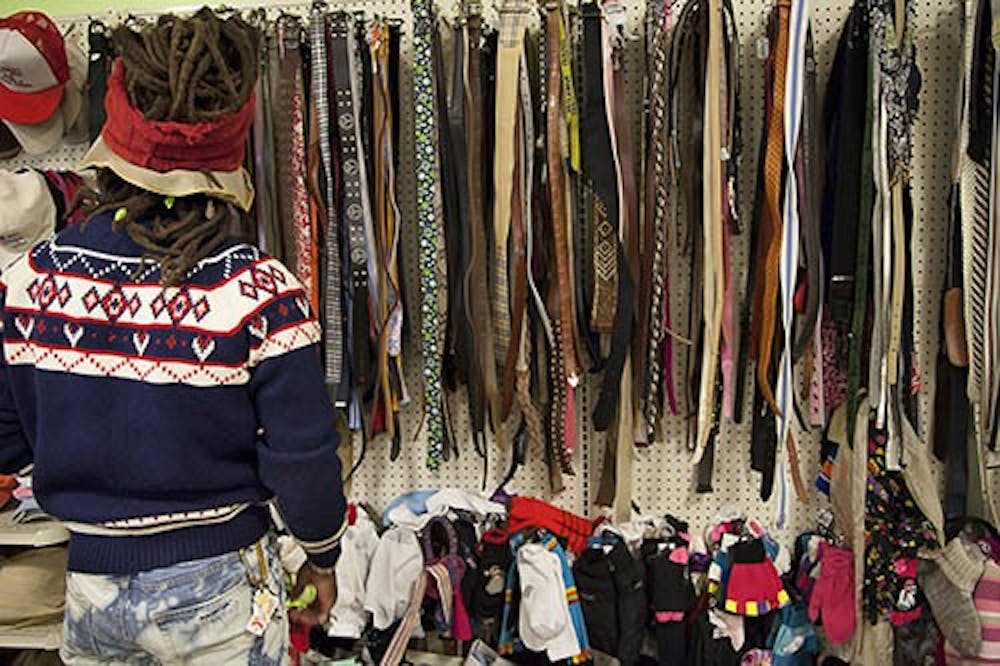Since Macklemore and Ryan Lewis were seen sailing through the aisles of Goodwill with giant fur coats, capes and footy pajamas, the thrift shop scene has gone mainstream. It’s clear that thrift stores aren’t just for old ladies and penny-pinchers anymore.
The trend has reached beyond the billboard chart topping song “Thrift Shop” and has been a consistently growing business. According to the National Association of Resale Professionals, the number of resale shops have increased by 7 percent in the last year. Goodwill currently operates 2,500 non-profit stores in the nation, and other similar stores are expanding.
Just as every garment on a thrift store clothes wrack is distinctly different, identical thrift shoppers do not exist.
Backgrounds, fashions, mindsets, price.
These are all potential influences on a thrift shopper’s style.
These thrifty students aren’t ashamed to take your grandpa’s style — but, no for real, ask your grandpa — can we have his hand-me-downs?
ENDLESS WARDROBE
Tyler Grube was one of thirteen children being raised by a single mom. For his family, thrift shopping was the main means of finding threads to save on cash. Today Grube still shops only at thrift and vintage stores. As a sophomore fashion design major at Ball State, he is acutely aware of his sense of style.
“I do it because part of what I consider to be fashionable is the illusion of having a seemingly endless wardrobe,” he said. “I just never want to be accused of always wearing the same thing and this system kind of keeps that from happening.”
Grube began keeping a journal of what he wore everyday toward the end of high school, ensuring that he did not repeat outfits. After wearing a specific set of clothes one day, Grube will not be seen in that set of clothes again for at least two weeks.
THREAD OF A TALE
With every garment Koledon Lambright wears, he is conscious of the piece’s original owner. Whether it was his grandmother or a random Goodwill donator, Lambright is mindful of the garment’s background.
“When I wear clothes, it’s a lot more about who had them prior to me,” Lambright said. “It’s a weird thing because usually people say, ‘Oh, my clothes identify me.’ But really, I use my clothes as a way to pay homage to the people who used to wear them.”
Through his wardrobe of thrifted gems and family hand-me-downs, Lambright throws societal expectations to the wayside, instead dressing for his own personal satisfaction.
THE EXCAVATOR
Every weekend, Algier Williamson embarks on his own personal treasure hunt. He readies his bike, making sure that it will be able to transport any goodies he may dig up on his venture.
When Williamson arrives at Goodwill, he expects to be searching for at least three hours. Upon arrival, he jumps into his routine, bouncing from section to section of the store, carefully scrolling through the wracks of miscellaneous garments.
“You go in there and you just keep an open mind,” Williamson said. “It’s just like a whole new world opens up at you because you’re scrolling through the wracks. Certain patterns, certain colors, certain fabrics — these are all the things I pay attention to instantly as I’m scrolling through.”
For Williamson, the ever-changing supply of clothes at thrift shops such as Goodwill is what truly makes them special. Being contained to his barbershop all week, Williamson’s weekend excursions allow for his mind to explore through means of fashion and style.
“I could tell you exactly everything that’s in the mall right now, but when I come in here, you never know,” he said, carefully examining clothes at his usual Muncie treasure chest. “This is what makes it so special.”
Another of Williamson’s hobbies is painting: an art that he believes defines how he goes about his clothing choices on a daily basis.
“It’s like I get to paint a picture everyday,” Williamson said. “Some days I feel bright and colorful. Some days it’s playful. Some days it’s serious. I like being able to exude that through clothes and fabrics and the things I put together.”
THRIFTY BUSINESS
Stephanie Cater has made a profit from second-hand hunting. She runs Broad Ripple Vintage with her husband John Solhan.
Selling only used items, the shop differs from thrift shops in its filtered shelf stocking; however, this hand-picked nature allows for Cater and Solhan to provide a curated thrift shop experience, sifting through the mounds of cloth to find gems to stock their racks.
“There are very few identical items. There’s not one in another size,” Cater said. “Until you get used to shopping this way, it’s hard.”
When it comes to used shopping, Cater believes an undoubted uniqueness comes with wearing used clothes, allowing for creativity to be channeled.
“If you can see past what it is now and see how you wanna use it, then you’re really in business because you can meld your own style together,” she said. “You don’t have to look like you just stepped out of a Sears catalogue circa ’68.”
Pat Jones, business coordinator at Muncie Mission Ministries, heads the operations at four Attic Window thrift shops, two in Muncie, one in Winchester and one in Hartford City.
Through the shops, MMM raises funds to provide food and shelter to homeless people, among other community service initiatives.
Jones said the store’s link to community betterment is what sets it apart.
“We like to say shopping at the Attic Window is like a treasure hunt — you never know what you’re going to find,” Jones said. “A thrift store shopper is different than a typical, regular shopper. Their attitude is they’re trying to find the needle in the haystack. They’re trying to find that treasure item that we’ve put really cheap that they can claim that they found that day.”


